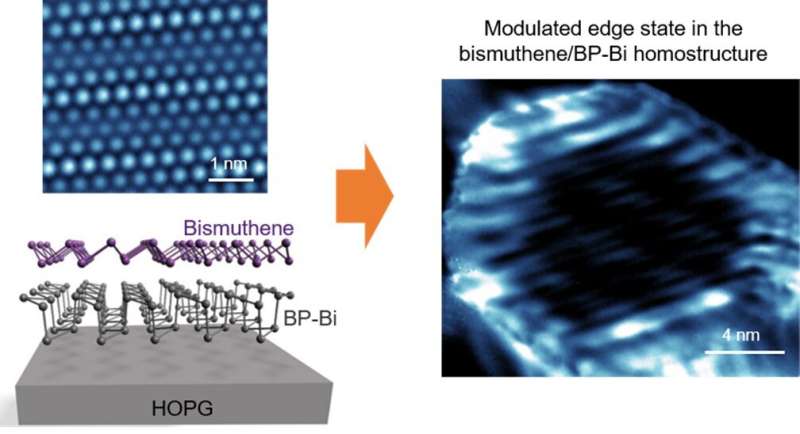Observing topological edge states using moiré patterns

NUS physicists have found a new way to create and tune the topological edge states in two-dimensional (2-D) topological insulators (TIs) for potential spintronic device applications.
A TI is a material that behaves as an insulator in its interior, but whose surface contains conducting states, meaning that electrons can only move along the surface of the material. Similarly, a 2-D TI is an insulating 2-D material, but whose electrons are allowed to move along its edges. 2-D TIs are promising candidates for spin electronics and devices with minimal/ negligible energy dissipation, such as quantum computers and ultra-low energy electronic devices. However, the fabrication of robust TIs and the reliable tuning of their topological states are challenging. In particular, 2-D bismuthene (bismuth monolayer with a honeycomb atomic structure) is predicted as the best candidate for a 2-D TI, but the preparation of free-standing modes in a single layer bismuthene has still not been realized, and the influence of the substrate on the topological states is unknown.
A research team led by Prof Andrew WEE from the Department of Physics, NUS has successfully created a bismuthene homostructure using molecular beam epitaxy (MBE). Using this low-temperature deposition method, a single layer of bismuthene can be grown on a single layer of black-phosphorus-like bismuth layer (BP-Bi) to form a vertical homostructure with different rotation angles between the two layers. As the two layers in the homostructure have different atom arrangements, the interlayer interaction between these two layers is observed to be largely reduced and periodically altered. This results in a nearly free-standing bismuthene monolayer with tunable topological edge states.
Moiré patterns are large area interference patterns produced when a periodic lattice is overlaid on another similar lattice, typically at a small relative rotation angle. This novel method of using the moiré pattern formed by rotating two 2-D materials relative to each other can potentially be used to purposefully control device performance.
Dr. GOU Jian, a research fellow in the team, explained, "Unlike 3-D semiconductors where the electronic properties are tuned by the introduction of doping atoms, the properties of atomically thin 2-D materials are easily modified by dopant atoms. Hence, the observation of topological state modulation by a bismuthene homostructure offers a damage-free method of controlling the electronic states in 2-D TI devices."
"The exciting field of twistronics has recently been demonstrated in graphene, and this work on bismuthene reveals its beauty in uncovering the topological edge states in a 2-D material," added Prof Wee.
The team plans to further investigate such novel moiré patterns, in the hope of realizing more robust tuning of the electronic states in 2-D TIs.
More information: Jian Gou et al. The effect of moiré superstructures on topological edge states in twisted bismuthene homojunctions, Science Advances (2020). DOI: 10.1126/sciadv.aba2773
Journal information: Science Advances
Provided by National University of Singapore





















